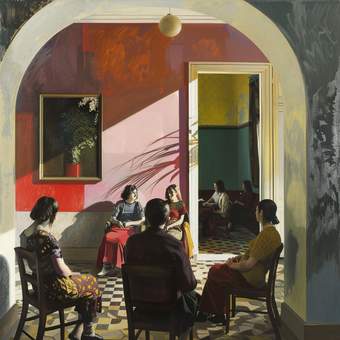London South Bank University and Royal College of Art, London
Supervised by Professor Andrew Dewdney, Professor of Educational Development (LSBU); Professor Victoria Walsh, Head of Programme, Curating Contemporary Art MA (RCA); and Ben Polhill, Web Developer, Tate Digital.
February 2024 –
Generative artificial intelligence is a form of predictive technology. It works through deep-learning algorithms trained to recognise pixel patterns in images, associate them with human concepts and generate new hybrid images, which are statistically likely to match a text prompt. In other words, generative AIs have been taught to see and understand visual objects and then to predict an image that the human user has in mind. This technology and creative medium is transforming visual culture. Every year billions of images are generated by individual users, on commercially available text-to-image generative platforms or customisable open-access models. This has technical, social and cultural implications, which have been the subject of numerous conversations since the launch of ChatGPT in 2020. The technology raises questions about bias, the artistic merits of predictive imagery, the risks posed to creative industries, ethics of data ‘scrapping’ on the web, but also about the innovative forms of creativity that are emerging. Art museums have been slow to engage with this technology and museological scholarship has yet to explore the potential impact and opportunities of this technology on museum activities.

Prompt: “what the future of British art collections looks like”. Image generated using Midjourney. © Sami Itavuori, 2024. CC BY-NC
‘Generative AI and the Art Museum’ is a practice-led research project in collaboration with Tate Digital aiming to produce new knowledge about predictive machine visuality and develop novel audience engagement practices. The project centres Tate’s digitised collection of British Art, of which 70,000 works are freely available online, as an outstanding resource to be activated by generative AI, as well as an object that resists datafication and enables the questioning of AI and its cultural components. Recent scholarship in museology and media has highlighted the opacity of artificial intelligence, its black box and the lack of public spaces where users and audiences can learn and engage with the technology and role in art, culture and society. The museum as a site of encounter with common heritage, specialised expertise, creative learning and collective meaning-making, can play a role in investigating this emerging visual culture and catalyse important conversations.
The project aims to produce knowledge about text-to-image generative AI as a technology and a creative practice in its own right. It will map the field of existing museum practices while providing avenues for its current and future impact in audience engagement activities related to digitised collections. Parallel to this theoretical work, the project adopts a methodology of continuous prototyping, which through practical experimentation and speculative design with generative AI seeks to inform the research and develop tangible models and artefacts leading to public facing activations of the digitised collection.
Generative AI is not something of the future, but something that happening right here and now. Tate’s rich digital presence and history of public engagement offer the perfect place to research this emerging form of visual culture and how the digitised collection of British art can be activated by this playful and opaque technology.
Sami Itävuori
Research Website https://ignorantvisions.cargo.site/
Research Profile https://www.centreforthestudyof.net/?page_id=7616
